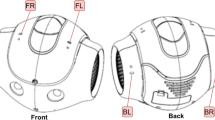Abstract
In order to improve the target location detection effect of mobile robots, this paper combines convolutional neural network and recurrent neural network to construct a model for solving abnormal sound event detection. Moreover, this paper constructs a convolutional neural network architecture suitable for feature extraction of audio signals, uses the recurrent neural network to classify each frame of audio signals, and applies the improved R-FCN deep convolutional neural network to the target location detection of mobile robots. In addition, this article uses Matlab to carry out system simulation construction, and design and use the system to carry out performance verification. Through experimental research, it can be seen that the target location system of mobile robot based on R-FCN deep convolutional neural network constructed in this paper can effectively improve the location speed and location accuracy compared with traditional location systems.











Similar content being viewed by others
References
Ayari A, Bouamama S (2017) A new multiple robot path planning algorithm: dynamic distributed particle swarm optimization[J]. Robot Biomimet 4(1):1–15
Balabonski T, Delga A, Rieg L et al (2019) Synchronous gathering without multiplicity detection: a certified algorithm[J]. Theory Comput Syst 63(2):200–218
Carius J, Wermelinger M, Rajasekaran B et al (2018) Deployment of an autonomous mobile manipulator at MBZIRC[J]. J Field Robot 35(8):1342–1357
Cheng TCE, Kriheli B, Levner E et al (2021) Scheduling an autonomous robot searching for hidden targets[J]. Ann Oper Res 298(1):95–109
Cherni F, Rekik C, Derbel N (2019) Mobile robot navigation based on tangent circle algorithm[J]. Int J Comput Appl Technol 59(1):31–42
Dames P, Tokekar P, Kumar V (2017) Detecting, localizing, and tracking an unknown number of moving targets using a team of mobile robots[J]. Int J Robot Res 36(13–14):1540–1553
El Shenawy A, Mohamed K, Harb H (2020) HDec-POSMDPs MRS exploration and fire searching based on IoT cloud robotics[J]. Int J Autom Comput 17(3):364–377
Gao Y, Chen H, Li Y et al (2017) Autonomous Wi-Fi relay placement with mobile robots[J]. IEEE/ASME Trans Mechatron 22(6):2532–2542
Golan Y, Edelman S, Shapiro A et al (2017) Online robot navigation using continuously updated artificial temperature gradients[J]. IEEE Robot Autom Lett 2(3):1280–1287
Goldhoorn A, Garrell A, Alquézar R et al (2018) Searching and tracking people with cooperative mobile robots[J]. Auton Robot 42(4):739–759
Hacene N, Mendil B (2019) Fuzzy behavior-based control of three wheeled omnidirectional mobile robot[J]. Int J Autom Comput 16(2):163–185
Hu J, Niu H, Carrasco J et al (2020) Voronoi-based multi-robot autonomous exploration in unknown environments via deep reinforcement learning[J]. IEEE Trans Veh Technol 69(12):14413–14423
Karakaya S, Kucukyildiz G, Ocak H (2017) A new mobile robot toolbox for MATLAB[J]. J Intell Rob Syst 87(1):125–140
Muthukumaran S, Sivaramakrishnan R (2019) Optimal path planning for an autonomous mobile robot using dragonfly algorithm[J]. Int J Simul Modell 18(3):397–407
Palmieri N, Yang XS, De Rango F et al (2019) Comparison of bio-inspired algorithms applied to the coordination of mobile robots considering the energy consumption[J]. Neural Comput Appl 31(1):263–286
Rostami SMH, Sangaiah AK, Wang J et al (2019) Obstacle avoidance of mobile robots using modified artificial potential field algorithm[J]. EURASIP J Wirel Commun Netw 2019(1):1–19
Sombolestan SM, Rasooli A, Khodaygan S (2019) Optimal path-planning for mobile robots to find a hidden target in an unknown environment based on machine learning[J]. J Ambient Intell Humaniz Comput 10(5):1841–1850
Unhelkar VV, Dörr S, Bubeck A et al (2018) Mobile robots for moving-floor assembly lines: design, evaluation, and deployment[J]. IEEE Robot Autom Mag 25(2):72–81
Victerpaul P, Saravanan D, Janakiraman S et al (2017) Path planning of autonomous mobile robots: a survey and comparison[J]. J Adv Res Dyn Control Syst 9(12):1535–1565
Zhang M, Liu X, Xu D et al (2019) Vision-based target-following guider for mobile robot[J]. IEEE Trans Industr Electron 66(12):9360–9371
Zhao R, Lee HK (2017) Fuzzy-based path planning for multiple mobile robots in unknown dynamic environment[J]. J Elect Eng Technol 12(2):918–925
Funding
The research is supported by: the 2018 Guangxi Vocational Education Professional Development Research Project "Development Research Base of Industrial Robotics and Intelligent Manufacturing Technology Professional Group" (No.2018080315); 2019 Guangxi University young and middle-aged teachers' research basic capacity improvement project "Research on unmanned AGV distribution system for non-ferrous metal melting and casting section" (No. 2019KY1572).
Author information
Authors and Affiliations
Corresponding author
Ethics declarations
Conflict of interest
The author declared that they have no conflicts of interest to this work. I declare that I do not have any commercial or associative interest that represents a conflict of interest in connection with the work submitted.
Additional information
Publisher's Note
Springer Nature remains neutral with regard to jurisdictional claims in published maps and institutional affiliations.
Rights and permissions
About this article
Cite this article
Cen, H. Target location detection of mobile robots based on R-FCN deep convolutional neural network. Int J Syst Assur Eng Manag 14, 728–737 (2023). https://doi.org/10.1007/s13198-021-01514-z
Received:
Revised:
Accepted:
Published:
Issue Date:
DOI: https://doi.org/10.1007/s13198-021-01514-z




